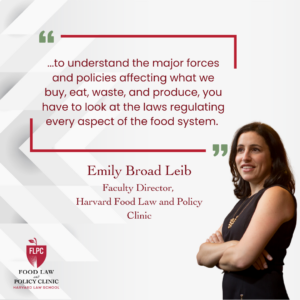This article was written by Kaitlin Bradshaw and originally published by Waste 360 on May 7, 2020.
The COVID-19 pandemic has caused several kinks in the food supply chain, making the recovery of excess food more difficult at a time when the population is increasing and already vulnerable to shortages.
During Waste360’s recent webinar, “The Impact of COVID-19 on the Food Supply & Feeding the Hungry,” food waste and food rescue experts provided their thoughts on the potential short-term and long term effects the pandemic may have on the food supply chain, what it means for food recovery and how food banks and agencies are pivoting to make sure excess food gets to the people who need it the most.
Discussing the virus’ effect were Dana Gunders, executive director of ReFED; Justin Block, managing director of retail information services at Feeding America; and Emily Broad Leib, clinical professor of law, director of the Food Law and Policy Clinic and deputy director of the Center for Health Law and Policy Innovation at Harvard Law School.
Gunders pointed out how far-reaching the impact of COVID-19 is on the food supply chain and how it has affected farmers, processors and manufacturers, distributors, grocery retail, and restaurants and food service.
“Typically there are fairly distinct supply chains that serve the food service industry – restaurants, hotels, schools, university campuses, corporate campuses – and overnight when all those businesses closed the supply chain closed with it,” Gunders said.
“So what you have is, all those farmers, distributors and processors who are serving that industry are looking for a new market. Meanwhile the grocery sector has been increasing their market share. So all those organizations are trying to get into retail but it’s simply not that easy,” she said. “Some are successful but many are still looking for a market or are going direct to consumer, or else they’re tilling fields over.”
Gunders said farmers are seeing their own waste increase as the market demand drops, particularly with specialty products that have trouble selling outside the restaurant market. Some farms are finding success in e-commerce and selling directly to the consumer.
Looking ahead, farmers are planting less seeds since the future of the market is unclear.
Processors and manufacturers on the other hand saw an increase in demand from grocery retailers when consumers were panic-buying and hoarding food when stay-in-place orders started. But production started to slow down with social distancing and striving to ensure the health and safety of employees who work in close quarters. Gunders said this is happening not only at meat processing plants but at beverage facilities and more.
Distributors that work directly with the food service industry are being left with a surplus of food from cancelled orders and no wholesale market to supply, Gunders said.
Grocery retail “is an interesting arena right now,” she said. Business has surged both in-store and electronically, while social distancing needs have prompted operational changes. “They’re struggling to keep up with all that different kind of demand,” she said.
The restaurant and food service industry took a giant hit by being forced to close, and as much as 15 percent of those operations might never reopen, Gunders said. A lot of restaurants donated inventory to food banks while others made changes to operate as take-out or delivery only.
On the food assistance side of the supply chain, Gunders said they’ve gotten feedback from food donors, donor recipients and other stakeholders on the key challenges they are facing. Those include including transportation issues, volunteers not showing up, limited cold storage for perishable food and funding.
“We are hearing concerns (that) despite what you’re hearing about extra food, some of those end-recipient agencies are experiencing or are about to experience a shortage of food,” Gunders said.
Organizations like Feeding America are working to connect the farmers and distributors with the agencies and food banks so the excess food that would normally go to the food service industry isn’t going to waste and instead is going to those who need it most.
Feeding America’s Block said 72 billion pounds of food goes to waste each year in the U.S. – the majority of which comes from consumers.
Feeding America’s mission is to not just provide more meals but also to reduce hunger in America and improve food security, Block said.
“Our network is 200-member food banks around this country. We have a presence in every county of the United States. Those 200 food banks work with over 60,000 soup kitchens and food pantries to not only source but distribute donated food to people facing hunger,” Block said.
There’s constant dialogue with member food banks regarding what’s working well in their communities, indentifying best practices, amplifying them and then replicating them elsewhere across the network, he said.
And now, with COVID-19, Block said a lot of the organization’s work is the same, there’s just more of it that needs to be done quickly and with more partners.
“Feeding America predicts an additional 17.1 million Americans will have trouble feeding themselves and their families as a result of the pandemic,” Block said.
But getting the excess food to where it needs to go is proving to be more of a challenge during the pandemic. Many of the people who regularly volunteer with Feeding America and its member food banks generally tend to be older and are now considered part of the at-risk population, Block said, so they can’t volunteer.
“There are gluts of food in different places of the supply chain, and our network has gotten reduced capacity to serve an increased number of folks who need charitable food assistance during this crisis,” Block said.
So with the increased demand but a shortage of volunteers, food banks are responding to these challenges by creating new partnerships and adopting new models to increase capacity, he said. And from these challenges they are finding new opportunities that can last beyond the pandemic.
For example, Block said Team Rubicon is volunteering at partner food banks to help supplement the reduced volunteer capacity as well as help run food banks more efficiently and effectively.
“Adopting new models. I was talking to a food banker yesterday who now instead of having one shift in the warehouse fully staffed, because of social distancing and because of different challenges, they’re now running 24 hours a day at one-third of the staff level, and they’re having more targeted tasks in these shifts,” Block said. “So now they’re going around the clock, employing the same amount of folks but they’re reducing the amount of folks on the floor at any given time realizing that this is resulting in new efficiencies because there’s less foot traffic and they can get a lot more done.”
“So that’s a new model that food bank was forced into as a response to COVID-19, but now as a network we can look at that model and bring efficiencies elsewhere,” he said.
New opportunities also have come from the federal level. The Department of Agriculture launched the Coronavirus Farm Assistance Program (CFAP), allocating $16 billion in direct payments to growers, dairy and meat producers, and $3 billion to purchase dairy, meat and produce to distribute to food banks and other nonprofits directly through distributors.
Block also talked about the Truck to Trunk program through which food banks coordinate directly with the distributor. That operator drives a refrigerated truck with five different types of boxes and will park parks at a large venue – malls, stadiums, airports – so recipients can have the food placed directly in their trunk.
In addition, Block pointed out Feeding America’s food donation app, MealConnect.
In addition to CFAP, the federal government has increased funding to The Emergency Food Assistance Program (TEFAP) through the Families First bill. States and municipalities can apply to the Federal Emergency Management Agency (FEMA) for money to feed people, and there has been some flexibility in food safety when it comes to requiring nutritional labels, according to Leib of the Harvard Law School FLPC.
The clinic provides legal and policy advice to nonprofits, government agencies, entrepreneurs, entrepreneurs and other organizations on a range of food policy questions, Leib said. Later this month the FLPC will be launching the new Global Food Donation Policy Atlas, which she said is “really relevant to this moment.”
Working with the Global Food Banking Network, Leib said “we’re working with food banks in 16 different countries to really understand, analyze and compare laws that structure food donation across those countries so we can see the challenges and best practices. We’re looking at things like tax incentives, barriers, liability protection, food safety questions around food donation” and more.
Leib echoed a lot of the points Gunders and Block made about the challenges associated with the missing links in the food supply chain, and like ReFED and Feeding America, FLPC is looking to turn the challenge into an opportunity.
Going forward, Leib said the FLPC is looking for more possibilities for funding to purchase and distribute food. The group is looking at potential tax benefits to create incentives for donations and to offset costs. The organization wants to address the barriers preventing more food donations and to create more flexibility.
To see everything the FLPC is doing in response to COVID-19, Leib said they put together a special resources page on their website.


Health Law & Policy, Commentary
Braidwood Management v. Becerra: Updated FAQs for Health Advocates and Providers
July 22, 2024